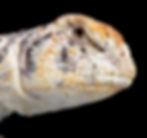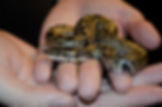
Leopard Gecko Care Guide
Leopard Gecko Care Tips: Everything You Need To Know About Your Pet Leopard Gecko
Leopard Geckos are particularly popular as pets because of their bright color and relative ease of maintenance. These beautiful animals are small, usually reaching just 7-10 inches in length and weighing only 45-60 grams. Best of all, Leopard Geckos can live up to 25 years, making them a lovely pet to bring owners long-term joy.
Considering a pet reptile? Learn more about turtles, uromastyx, iguanas and more.

The Natural History of Leopard Geckos
Geckos are an incredibly diverse group of lizards, with over 1,500 species worldwide. Each biome has produced geckos with their own unique traits, from size to coloring. Leopard Geckos are unique for having movable eyelids. That means Leopard Geckos blink rather than licking their eyes like most other geckos. They are also unusual because they can’t scale walls; most gecko species have toe pads that make them champion climbers.
Leopard Geckos originated in arid areas of Afghanistan, India and Pakistan. These are hot areas of the world, so the Leopard Gecko is nocturnal, preferring to spend days hiding in a shady spot. Though other color patterns can be found due to extensive breeding in captivity, Leopard Geckos, as their name suggests, are typically yellow with dark spots.
How to Care for Your Pet Leopard Gecko
Leopard geckos are generally easy to take care of and don’t require much fuss. However, as with any pet, your new gecko should be brought to an experienced reptile vet ASAP for a wellness exam.
Give Your Pet Time to Adjust
When you take your new friend home, be sure to keep it alone in its own tank and a low-traffic area of the house for a month so it can adjust to its new environment.
Do Not Cohabitate Geckos! If you have two or more leopard geckos, make sure that they do not share a tank, as they will fight each other (sooner or later). They should also not be picked up by the tail or placed in a situation where they will interact directly with dogs, cats or other potential predators. This both scares them, and puts their life at risk.
Housing for Your Leopard Gecko
A Leopard Gecko can be comfortably housed in a 20-gallon aquarium covered with a screen top to provide good air flow. The tank should include multiple hiding places in both the cool and warm side of the tank, which should range from 70-90 degrees with the help of heat bulbs.
Low-level UVB lights are a great addition to any tank, as they can aid in the absorption of vitamin D and synthesis of calcium . One hide in particular should be cleaned weekly and kept humid with sphagnum moss or a wet sponge to help your gecko shed its skin.
Learn more about choosing the right heat bulb for your reptile cage.
When it comes to substrate, paper towels, reptile carpet or ceramic tile are all recommended. Avoid loose substrates such as sand, dirt, corncob and walnut shell as they are more difficult to clean and come with a higher risk of impaction injuries.


Leopard Gecko Behavior
A well-socialized gecko can be friendly to humans. When handling your gecko, support their whole body weight rather than lifting them by the tail as this can cause them to drop their tail out of pain and/or fear.
Is My Pet Gecko a Male or Female?
It is usually quite easy to identify your leopard gecko’s sex. Males can be identified by the V-shaped row of enlarged preanal pores along their inner thighs, as well as two hemipenal swellings at the base of the tail. Geckos reach sexual maturity at around 10 months, before which there is little difference between males and females.
Leopard Gecko Diet & Nutrition
Leopard Geckos are insectivores. They should be fed a variety of live insects, including crickets, mealworms, superworms, silkworms and dubia roaches. Hornworms and waxworms can be offered as a treat as they are not very nutritionally dense (but can be tasty!) The insects should be gutloaded with a high-quality diet of greens, vegetables and fruits for at least 24 hours before consumption by the gecko.
Prey insects should be no longer than the gecko’s head and about half its width. Calcium without d3 should be dusted on the insects daily, calcium with D3 should be dusted once a week, and a multivitamin should be dusted 1-2 times a month.
Avoid the temptation of feeding your pet gecko insects from the garden; they are often contaminated by parasites and pesticides.
What Medical Care Does My Pet Leopard Gecko Need?
While geckos can be low-maintenance pets and generally live long lives, they are vulnerable to a number of health risks including intestinal parasites, metabolic bone disease, necrotic toes, stomatitis, respiratory infections and eye inflammation.
Regular checkups at an exotics veterinary clinic is the best way to screen for and hopefully prevent, such issues. Providing your gecko with the right diet and husbandry is the most important way to ensure a long, happy and healthy life.
How Can You Tell If Your Leopard Gecko Is Sick?
Behavioral changes should always be monitored. Look out for lethargy, star-gazing, and inappetence. However, reptiles can often hide their symptoms for a long time if they are feeling ill. If you are noticing symptoms, the issue has likely been going on for a lot longer than initially noticed. Annual wellness exams at your exotic vet is the best way to ensure your leopard gecko is healthy and not attempting to disguise any underlying illnesses.
If your gecko is behaving strangely or showing other signs of illness, it is always recommended to make an appointment with your exotic pet vet as soon as possible.












